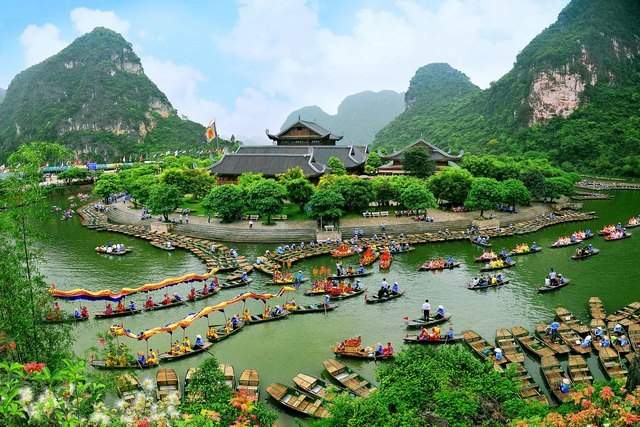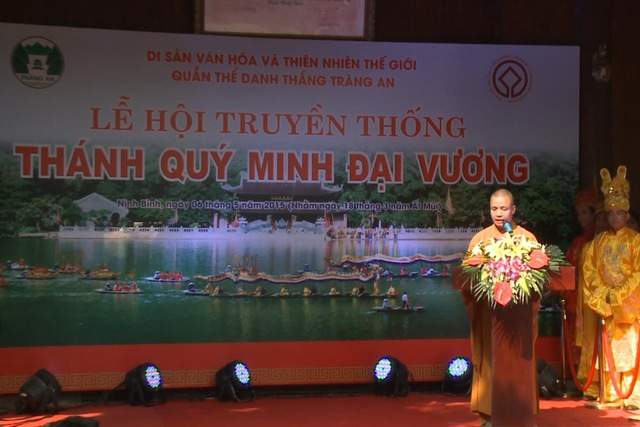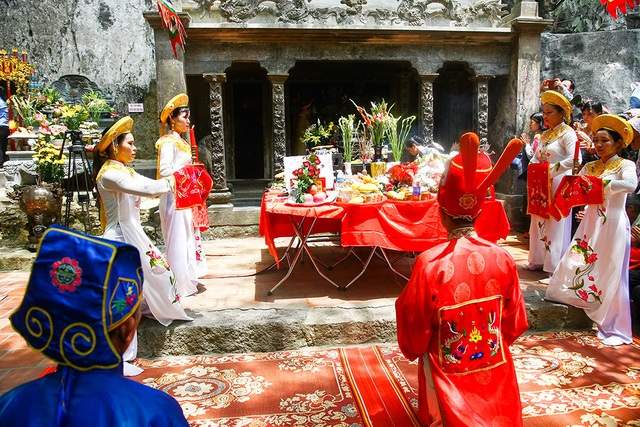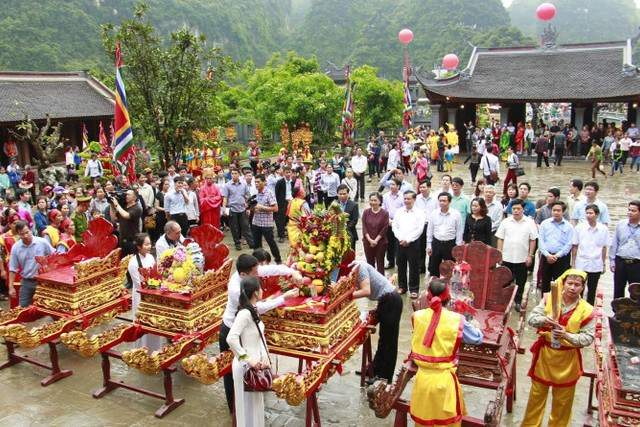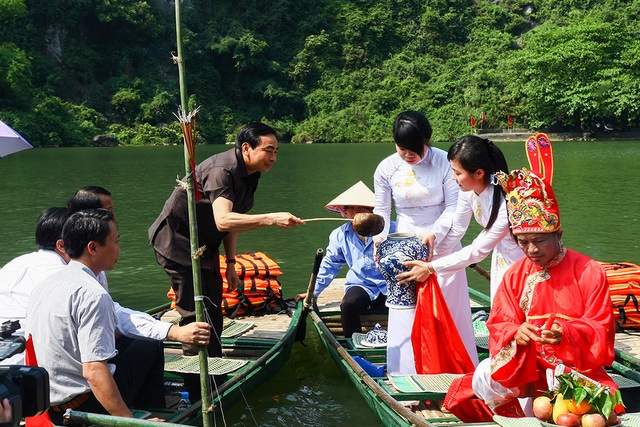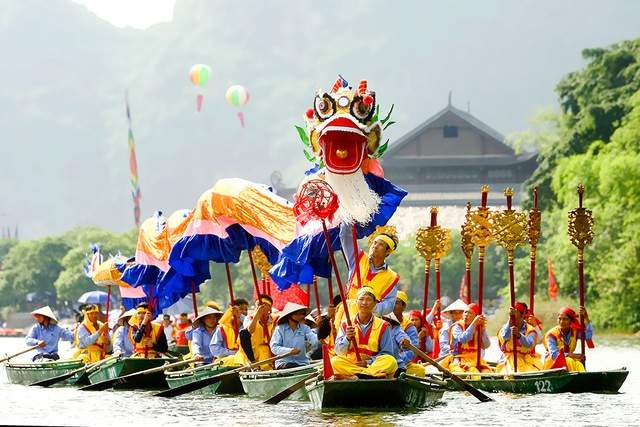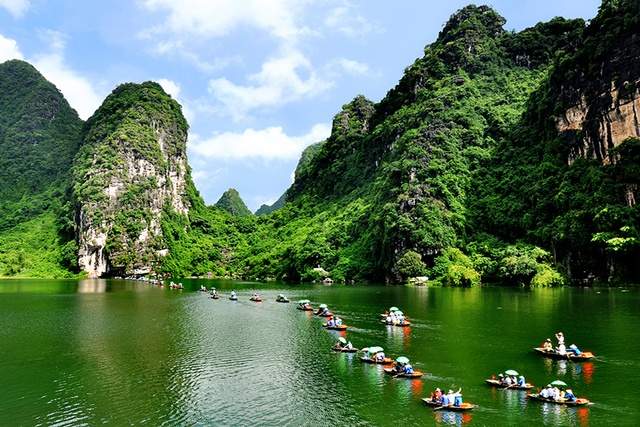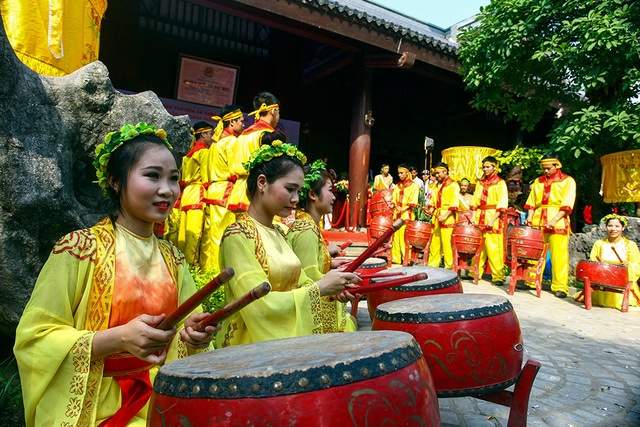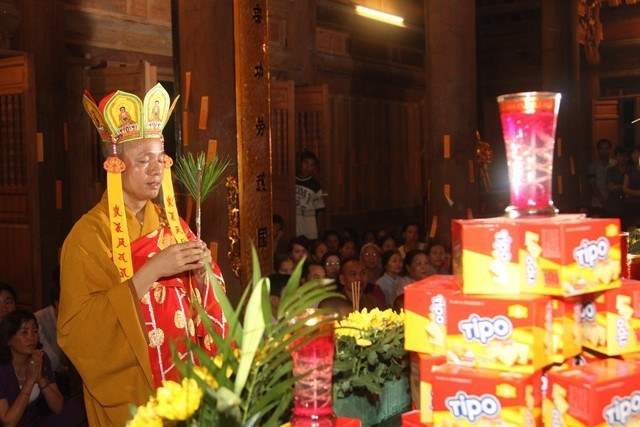Unique Trang An Festival – The Cultural and Religious Essence of Ninh Binh
The Trang An Festival isn’t just a local event in Ninh Binh; it extends its significance beyond a national celebration with the participation of national leaders and international friends. Every year, on the 18th of the lunar calendar, people gather in Ninh Binh to take part in this remarkable festival.
1. Trang An – The First Dual Heritage Complex in Southeast Asia
Trang An is hailed as a Heritage Complex for its synthesis of numerous renowned attractions in Ninh Binh, such as Tam Coc – Bich Dong, the ancient capital of Hoa Lu, Bai Dinh Pagoda with multiple Asia records, Thung Nang – Thung Nham, Thien Ha Cave, Mua Cave, and Vu Lam Palace. Consequently, Trang An boasts an impressive 6,172 hectares, primarily consisting of paddy fields and villages. In 2014, Trang An Scenic Landscape Complex was officially recognized by UNESCO as the first and only dual World Heritage Site in Southeast Asia up to the present moment. Additionally, it holds significant national heritage status. As of 2019, Trang An has attracted millions of visitors, predominantly local tourists and international guests.
2. Unique Trang An Festival – The Cultural and Religious Essence of Ninh Binh
2.1. Overview of the March Festival in Ninh Binh – Trang An
The Trang An Festival is a series of cultural and religious activities combined with tourism, closely linked to the mountain deities in the ancient capital of Hoa Lu. The people living within the Trang, A World Heritage Complex in Ninh Binh, revere nature. Thus, the festival takes place annually on the 18th of the lunar calendar. Its primary purpose is to honor the deities Quy Minh, Cao Son, and the Giant who guard Hoa Lu, the ancient capital, the kings of the Tran dynasty who established Vu Lam Palace, and the generals of the Dinh dynasty stationed in Trang An. The festival lasts for three days, with the most distinctive feature being the procession on the river. Visitors will have the opportunity to immerse themselves in the colorful atmosphere of the festival while exploring historical sites, caves, forests, and the rivers of Trang An.
2.2. The Significance of the Trang An Festival
The Trang An Festival, also known as the Worshiping Festival of Quy Minh, is held annually to commemorate the merit of the Duke Saint Quy Minh Dai Vuong, also known as the Saint Quy Minh. According to oral tradition passed down through generations, Saint Quy Minh Dai Vuong was a general under the 18th Hung King who defended the nation’s southern borders. Additionally, he assisted the people in building prosperous lives. Therefore, he was highly respected and worshipped by the ancient people. Recognizing his valuable contributions, King Dinh Tien Hoang bestowed upon him the title of a guardian deity of the southern gateway of Hoa Lu, which is now known as the ancient capital of Hoa Lu. Besides Saint Quy Minh Dai Vuong, Hoa Lu has three other deities guarding its eastern, western, and northern directions: Thiên Tôn, Cao Sơn, and the Giant. The Trang An Festival is an important religious tradition of the ancient capital, Ninh Binh, known for being the land of Kings, Saints, and Deities.
2.3. The Procession Journey
The Trang An Festival starts with an opening ceremony featuring a performance that vividly reenacts the daily lives of the Vietnamese people in the ancient capital of Hoa Lu on an outdoor stage near the central pier of Trang An. Following this, visitors embark on a boat journey along the flow of the Sao Khe River, heading towards the central area of the Trang An scenic complex to witness further performances that recreate some activities of the army and people of Dai Co Viet in ancient times, offering insights into the psyche of King Dinh Tien Hoang’s character. Next, the procession and visitors sail past various landmarks: the temple dedicated to the two generals of the Dinh dynasty, Vu Lam Palace, Cao Son Temple, and concluding at the Fairy Stream Temple.
The highlight of the Trang An Festival is undoubtedly the water procession, featuring floats and dragons on the river. During this spectacle, visitors are treated to colorful costumes and elegant performances reminiscent of silk floating gently through the air. The ceremony is conducted with great solemnity and adherence to traditional rituals, expressing gratitude and respect to the ancestors who contributed to the peace and prosperity of the nation. Furthermore, since the festival takes place on the Sao Khe River, it doesn’t remain stationary. Still, it moves through various renowned attractions of Trang An, such as Vu Lam Palace, Cao Son Temple, and Fairy Stream Temple, where rituals are performed. Therefore, the Trang An Festival serves as an opportunity to showcase the nation’s unique cultural and religious aspects while cleverly highlighting the majestic landscapes and natural beauty to international visitors.
In addition to the ceremonial aspect, the festival’s fair is a highly anticipated feature. Here, visitors can immerse themselves in outstanding cultural performances such as gong dances, traditional opera, and folk songs performed directly on boats. Transitioning from stage performances to the deck of a small boat, with a helmsman at the rear, provides a unique and enjoyable experience. Moreover, both sides of the river organize traditional games for visitors, ensuring a fun-filled experience.
3. The Evolution of the Trang An Festival Over the Years
3.1. The Trang An Festival in 2019
The 2019 Trang An Festival took place over two days – April 21 and 22, 2019, under the theme “Convergence of Essence in the Ancient Stone Capital.” The festival authentically reenacted Vietnamese history through the Dinh – Le – Ly – Tran dynasties in the land of the ancient capital of Hoa Lu – a stronghold against foreign invaders, characterized by its unique architectural style with mountains as walls, rivers as roads, and caves as palaces. The event was grandly organized, featuring dragon processions, vibrant dragon dances on the Sao Khe River, visitors transported to caves, and the Fairy Stream Temple to witness special worship ceremonies paying tribute to Saint Quy Minh Dai Vuong. Additionally, the fair included numerous artistic activities to promote culture and nature through ceremonial songs, Van singing, and Cheo opera performances.
3.2. The Trang An Festival in 2020 & 2021
The Trang An Festival in 2020 and 2021 was not held due to the COVID-19 pandemic.
Through this article, it is hoped that you have gained a deeper understanding of the Trang An Festival – one of the grandest festivals of the Vietnamese people. Not only does it remind us of the spirit of gratitude and the importance of remembering our roots, but it also creates opportunities to promote tourism to local and international visitors. Therefore, if you happen to be visiting Ninh Binh around the lunar month of March, be sure not to miss the Trang An Festival!
